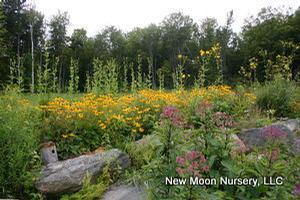New Moon Nurseries
Eupatorium dubium
Three-nerved Joe pye
Native to North America
FIRST IMPRESSIONS: Eupatorium dubium is a compact version of the much loved tall lanky Joe Pye Weed. Leaves are bright green and whorled around sturdy purple stems. The toothed foliage and robust stems are attractive even when plants are not in bloom. In mid-summer, plants are topped with a frothy crown of mauve-pink flower clusters. This species thrives in sunny moist sites where it is frequented by fluttering butterflies.
HABITAT & HARDINESS: Eupatorium dubium occurs in the eastern United States within 100 miles of the Atlantic Ocean. The range extends from Maine through coastal New England and the Coastal Plain to South Carolina.
This species is indigenous to marshes, shores, swamps, bogs, wet meadows, damp thickets, open woodlands, roadsides, swales and ditches.
Plants are hardy from USDA Zones 4-8.
PLANT DESCRIPTION: Eupatorium dubium is an upright perennial with multiple unbranched stems. The stems are sturdy and solid inside and are usually speckled with purple.
Large lance shaped leaves are arranged in whorls of 3 or 4 along the stems. The blades are toothed with resinous dots beneath. Two veins are prominent – running parallel to the leaf margin on either side of the mid-rib.
From mid-summer until autumn, plants bear terminal dome shaped flower corymbs that range from 3-10” across. These flower clusters consist of many small feathery lavender-pink disk florets.
The blossoms mature into soft buff colored seed clusters.
Plants are 2-5’ tall with 2’ spread.
CULTURAL & MAINTENANCE NEEDS: This wildflower grows best in full sun with well drained moist soil, clay or wet soil. If moisture is absent, leaves are likely to scorch.
This species is more shade tolerant than many other Eupatorium spp. Plants tolerate part sun or part shade.
Eupatorium dubium is pest resistant and foliage is unpalatable to deer and other herbivores.
Deadheading will not stimulate re-bloom so flowers should be allowed to set seed. The seed clusters are attractive and will feed the birds and provide nesting material.
LANDSCAPE USES: Eupatorium dubium is a good Accent Plant for a Wildlife Garden or moist Meadow. Plants are also used as Butterfly Nectar Plants, Cut Flowers or as part of a Grouping or Mass Planting. This wildflower has Showy Blooms and provides Erosion Control. It can be used in Cottage Gardens, Deer Resistant Plantings, Rain Gardens, Water-wise Landscapes, Low Maintenance Plantings, Perennial Borders, Shade Gardens, Wetlands and on Roadsides.
COMPANION & UNDERSTUDY PLANTS: Try pairing Eupatorium dubium with Coreopsis tripteris, Lobelia siphilitica, Hibiscus moscheutos, Rudbeckia fulgida var. fulgida, Solidago rugosa, Panicum virgatum or Sorghastrum nutans.
Although plants are shorter and flowers are blue, Eupatorium coelestinum could be substituted in some situations. Eupatorium fistulosum could also be a worthy substitute if a taller plant was acceptable.
TRIVIA: Joe Pye flowers provide nectar and pollen for bees, butterflies, skippers and other beneficial insects. Seeds feed granivorous birds and the fluffy pappus seed attachment provides nesting materials.
Taxonomists recently changed the name of this species to Eutrochium dubium.
Joe Pye was reported to be an 18th or 19th century naturalist or herbalist from New England. He is said to have cured people of typhus fever by using Eupatorium spp. roots to induce sweating.
Height:
2-5 ftSpread:
2 ftSpacing:
3-4 ftUSDA Hardiness Zone:
4-8Bloom Color:
PinkEupatorium dubium Characteristics
Attracts Wildlife
- Butterflies
- Songbirds
- Pollinators
Attributes
- Dried Flower
- Cut Flower
- Naturalizing
- Clay Soil
- Long Blooming
- Bog
- Rain Garden
- Fragrant
- East-Coast Native
- Drought Tolerant
Exposure
- Full Sun to Partial Shade
Deer Resistant
- Deer Resistant
Flowering Months
- August
- July
- September
Foliage Color
- Green
Growth Rate
- Fast
Juglans nigra Tolerance (Black Walnut)
- Yes
Season of Interest (Foliage)
- Summer
- Spring
Soil Moisture Preference
- Moist to Wet
Interesting Notes:
For more information on this plant, visit the USDA PLANTS Database: http://plants.usda.gov/java/profile?symbol=EUDU6
